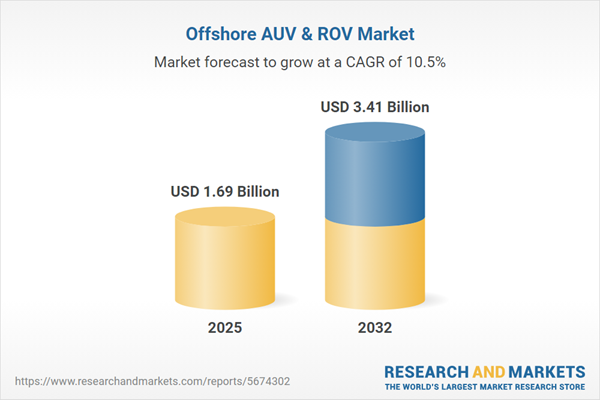Speak directly to the analyst to clarify any post sales queries you may have.
The offshore AUV and ROV market is transforming subsea operations for energy, marine, and defense organizations, thanks to advanced robotics that enable safer, more efficient project execution in complex underwater environments.
Market Snapshot: Offshore AUV & ROV Market
The offshore AUV and ROV market is experiencing robust growth due to the expanding scope of subsea projects across energy, defense, and marine research sectors. Analysts forecast a compound annual growth rate (CAGR) of 10.54% through 2032, fueled by demand for both autonomous and remotely operated vehicles capable of handling diverse and demanding underwater missions. Recent technological advancements in automation and robotics deliver greater operational reliability, expanding support for key offshore tasks like asset inspections, infrastructure maintenance, and data acquisition. Innovative subsea robotic platforms help reduce risk, streamline project timelines, and enhance asset management, ensuring operational continuity even in challenging marine conditions.
Comprehensive Scope & Segmentation
This report provides senior decision-makers with data-backed segmentation and actionable intelligence for optimizing capital and operational investments in the offshore AUV and ROV market. Each segment highlights specific applications and strategic considerations for advanced subsea robotics:
- Vehicle Types: Coverage ranges from large-scale specialized subsea robots to compact, highly portable models, each adaptable for unique operational demands and diverse marine environments.
- Applications: Detailed analysis of use-cases, including offshore asset inspections, subsea construction projects, marine survey missions, infrastructure upkeep, cable installation, mine clearance, emergency response, digital content generation, security surveillance, and subsea data collection.
- End User Industries: Strategic review of adoption and integration in sectors such as aquaculture, defense, marine research, telecommunications, oil, and gas, with a focus on sector-specific operational challenges and requirements.
- Depth Capabilities: Insights into engineering solutions supporting both shallow-water operations and ultra-deepwater missions, emphasizing innovations designed to meet evolving maritime complexities.
- Operation Modes: Assessment of tethered and untethered (autonomous) systems, including flexible deployment strategies tailored to varied offshore project needs and site accessibility.
- Propulsion: Examination of electric, hybrid, and hydraulic propulsion technologies engineered to enhance endurance and maneuverability in extreme underwater conditions.
- Power Sources: Review of battery and fuel-cell innovations that extend operational life and maintain performance consistency during demanding missions.
- Communication Methods: Analysis of acoustic, optical, and wired communication protocols enabling secure, real-time remote control and data transfer in subsea environments.
- Regions: Coverage of market dynamics and regulatory nuances in the Americas, Europe, Middle East, Africa, and Asia-Pacific, illustrating the impact of local adoption strategies and policy frameworks.
- Major Companies: Profiles of key players including Oceaneering International, Forum Energy Technologies, TechnipFMC, Subsea 7, Saipem, Baker Hughes, Fugro, Kongsberg Maritime, Teledyne Technologies, and Saab AB, with focus on innovation pipelines and supply chain evolution.
Key Takeaways for Industry Stakeholders
- Modern subsea robotics facilitate agile project execution by enabling tailored responses to changing site and mission requirements.
- Strategic cooperation between defense entities, energy firms, and technology vendors results in solutions that enhance operational flexibility and project oversight.
- Procurement increasingly centers on securing resilient supply chains and adherence to evolving regulatory and environmental standards, aiding stability during market fluctuations.
- Regional market growth is influenced by infrastructure modernization in North America, the adoption of renewables within EMEA, and surging investments in aquaculture and advanced communications across Asia-Pacific.
- Asset management is advancing through digital twin models and modular payload platforms, supporting greater reliability and predictive maintenance for mission-critical subsea infrastructure.
Tariff Impact and Strategic Response
Forthcoming United States tariffs in 2025 are prompting a reevaluation of sourcing and production strategies across the offshore AUV and ROV market. Leading organizations are strengthening operational resilience by diversifying suppliers, establishing new industrial partnerships, and optimizing site planning. These measures support continued project delivery and mitigate tariff-related uncertainties.
Methodology & Data Sources
Report insights derive from direct interviews with project managers, supply chain experts, and subsea technology specialists. Research validation further includes analysis of patents, regulatory filings, independent market studies, and comprehensive value chain reviews.
Why This Report Matters
- Enables executive teams to benchmark performance and refine strategies with credible market intelligence tailored to the offshore AUV and ROV sector.
- Supports effective navigation of technical, legislative, and operational challenges in mature and emerging offshore markets worldwide.
- Reveals actionable pathways for growth, innovation, and differentiation in the fast-evolving realm of subsea robotics solutions.
Conclusion
Rising adoption of subsea robotics, combined with robust sourcing strategies, is reshaping offshore project delivery. This report empowers leaders to advance agility and maintain performance within a continually shifting market landscape.
Additional Product Information:
- Purchase of this report includes 1 year online access with quarterly updates.
- This report can be updated on request. Please contact our Customer Experience team using the Ask a Question widget on our website.
Table of Contents
3. Executive Summary
4. Market Overview
7. Cumulative Impact of Artificial Intelligence 2025
Companies Mentioned
The companies profiled in this Offshore AUV & ROV market report include:- Oceaneering International, Inc.
- Forum Energy Technologies, Inc.
- TechnipFMC plc
- Subsea 7 S.A.
- Saipem S.p.A.
- Baker Hughes Company
- Fugro N.V.
- Kongsberg Maritime AS
- Teledyne Technologies, Inc.
- Saab AB
Table Information
| Report Attribute | Details |
|---|---|
| No. of Pages | 182 |
| Published | October 2025 |
| Forecast Period | 2025 - 2032 |
| Estimated Market Value ( USD | $ 1.69 Billion |
| Forecasted Market Value ( USD | $ 3.41 Billion |
| Compound Annual Growth Rate | 10.5% |
| Regions Covered | Global |
| No. of Companies Mentioned | 11 |









